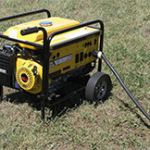Carbon Monoxide
 Carbon monoxide is known as the “silent killer” and is an odorless, tasteless and colorless gas. The Centers for Disease Control estimates that carbon monoxide claims nearly 400 lives and accounts for more than 20,000 visits to hospital emergency departments each year. Early symptoms of carbon monoxide poisoning are often mistaken for the flu and include headache, nausea and fatigue. Prolonged exposure can result in brain damage and even death.
Carbon monoxide is known as the “silent killer” and is an odorless, tasteless and colorless gas. The Centers for Disease Control estimates that carbon monoxide claims nearly 400 lives and accounts for more than 20,000 visits to hospital emergency departments each year. Early symptoms of carbon monoxide poisoning are often mistaken for the flu and include headache, nausea and fatigue. Prolonged exposure can result in brain damage and even death.
Where Does Carbon Monoxide Come From?
Carbon monoxide is formed when organic compounds burn. The most common sources are smoke from fires, engine fumes, motor vehicle exhaust and non-electric heaters. It is often associated with malfunctioning or obstructed exhaust systems.
Sources of carbon monoxide include:
- Gas water heaters
- Gasoline and diesel powered generators
- Boat engines
- Car exhaust
- Kerosene space heaters
- Indoor tractor pulls
- Propane-fueled forklifts
- Generators
Prevention Strategies
- Install a carbon monoxide alarm on each level of your home or boat.
- Inspect and clean your home heating system, chimney and flue each year.
- Do not operate gasoline-powered engines in confined areas such as garages or basements.
- Do not burn charcoal inside your home.
- Do not block or seal shut exhaust flues or ducts for appliances such as water heaters, ranges and clothes dryers.
- Do not leave a car, mower, generator or other vehicle running in an attached garage, even with the door open. Place generators in well ventilated locations outdoors away from all doors, windows and vent openings.
- Do not heat your home with a gas oven.
- Be aware of symptoms to watch for, including a dull headache, weakness, dizziness, vomiting, nausea, confusion, blurred vision or loss of consciousness. Seek medical attention immediately if you suspect carbon monoxide poisoning. Call your local poison center at 1-800-222-1222 if you have any questions.
For more information and flyers about carbon monoxide safety visit the Florida Department of Health. (http://www.floridahealth.gov/environmental-health/carbon-monoxide/index.html ) or the Centers for Disease Control and Prevention. (http://www.cdc.gov/co/ ).

